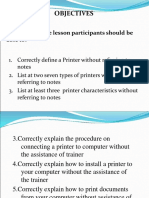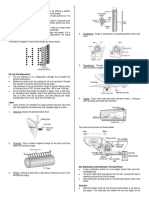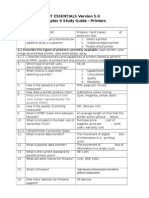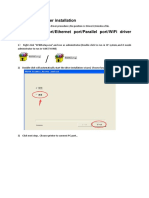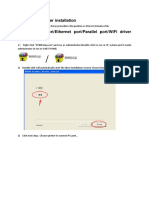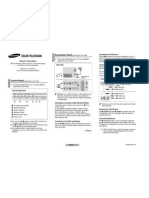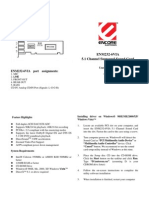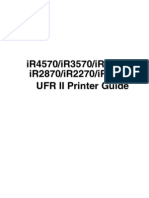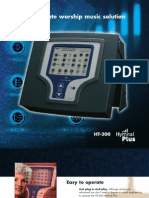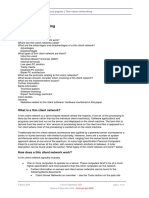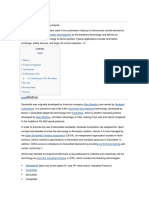Installing a scanner manually
You can install a scanner manually by completing the following steps: 1. In Windows Explorer, access C:\Program Files\Windows Photo Viewer, where C: is your system drive, and then double-click ImagingDevices.exe. 2. In the Scanners and Cameras window, click Add Device. This starts the Scanner and Camera Installation Wizard. 3. Click Next. 4. You must now specify the device manufacturer and model. This allows Windows 7 to assign a driver to the device. If the device manufacturer and model you are using are displayed, choose a manufacturer and a model, and then skip steps 57. 5. If the device manufacturer and model youre using arent displayed in the list, download the driver from the manufacturers website and then extract the driver files. 6. Click Have Disk. In the Install from Disk dialog box, click Browse. 7. In the Locate File dialog box, locate the .inf driver file for the device and then click Open. 8. Click Next. On the What is the name of your device? page, type a name for the scanner or accept the default name. Youll see this name in the Scanners and Cameras window. 9. Click Next and then click Finish. 10. The Scanners and Cameras window will have an additional icon with the name set the way you specified. You can change the scanner properHow to Install a Printer for a Computer
�How to install a printer
Having a printer is very essential when it comes to printing documents whether a computer is for personal home use or in the office. You can also use high-end printers to develop quality pictures. The printer that you would install should be appropriate to the hardware of the computer. There are printers using the parallel port and some prototypes connected through the Universal Service Bus (USB) port. In order to install a printer onto a computer, you should first check the BIOS settings if the parallel port is configured appropriately. Materials Needed: - Printer - computer with Enhanced Parallel Port (EPP) or Extended Capabilities Port (ECP) - printer installation CD - Internet connection (optional) Step 1 Turn on the computer. Wait for the computer to completely load the OS. Step 2 Attach the printer cable to the corresponding parallel port. After you securely connect the printer to the computer, turn on the printer. Windows will automatically detect the new printer and would prompt you to install the required drivers. Some printers may not be detected automatically by the computer. To manually detect the printer, click the 'Printers and Faxes' available on the 'Start' Menu. Double click the 'Add Printer' icon to launch the Add Printer wizard. If the computer still did not detect the attached printer, unplug and adjust the connection of the printer to the computer. Step 3 The wizard would ask you to choose between a Local Printer and a Network Printer. The computer searches for the connected printer after you select the type of printer. Step 4 The computer prompts you to install the needed driver. The printer usually comes with an installation CD which contains the drivers of the printer. Insert the
�installation CD on the CD tray. The computer automatically detects the driver files on the CD. Step 5 You need to manually detect the driver required for the installation just in case the driver is not detected. Select from the predefined list of driver software depending on the manufacturer and the model of the printer. Step 6 You may now proceed to perform a Windows update if you still cannot find the driver for your printer. You need to connect to the Internet in order to gather components from the online Windows product support. Step 7
Troubleshooting Common Printer Problems
The computer finalizes the installation procedure after the driver is successfully installed. A notification would appear informing you that you have successfully installed the printer. A printer icon would appear on the taskbar. This enables easy access to the configuration and maintenance settings of your printer.ties and check scanner status at any Troubleshooting Common Printer Problems
Kenyon has many networked printers, both public printers (in public computing labs and other public areas) and departmental printers. Public printers are available to any Kenyon member, while departmental printers are restricted to the members of that department or group. All networked Windows printer queues are the \\printers.kenyon.edu server.
Reporting printing problems:
When printing problems are reported to the HelpLine, the following information is needed: The caller's name, the building/room location; the printer name; the software (program) being used to print; and error messages or symptoms of the problem. All networked public printer problems have an emergency priority level, to be handled immediately, since they serve many users.
�Types of Printing Problems:
Printing problems can be divided into three basic types:
The printer equipment may be causing the problem. Examples of equipment problems are: Faulty rollers; broken paper trays; printer display menu "maintenance" messages; odd sounds; paper jams; "low toner" messages. This problem is handled by LBIS printer technicians. The print queue on the network may be causing the problem. Examples of print queue problems are: Error messages saying queue is "unavailable" or "cannot connect; "printer busy or error" messages, indicating print job is stuck in the queue; problems adding a network printer; printer not communicating with the network. Queue problems are handled by LBIS network managers. The software through which the print job is being printed may be causing the problem. Examples of software problems are: corrupt printer drivers (software)have to be re-installed; error messages in application being used, stating that paper trays, paper feeds or paper sizes are incorrect; "error initializing output device" messages, indicating a temporary glitch in communication between the software and network; "insufficient memory" error messages, indicating an (image) file size may be too large for the printer. Software problems are investigated
Importance of Printers
Printers play a vital role in everyday lives only that they have become plain and ordinary that people hardly even notice them. It is funny how people actually treated these printing gadgets too easy to possess and ordinary when people before would have to wait for days just to get their printed materials ready. The history of printing could be dated back to a few hundreds of years back but then there are so many things that have changed in the course of years that there are a lot of new gadgets that have evolved to make life more convenient for everyone. Getting all of these gadgets does mean a lot of help to people. There are a lot of convenient things that a person could experience because of these printing machines and here are a few of those:
� Your children would have to simply get their projects printed directly without having to face any problem at all. Before, children at school would have to line up in long lines just so they can have their projects ready for submission. When computers were an impossible concept, students would have to type their works individually which is why there seems to be no reason for teachers to task such a tedious job (unless they are terror teachers who want to make things difficult for their students). Now that printers are available, then the kids could simply do their reports conveniently with the computer and print it right away. They could even get an option of whether they will print it with graphics that are colored or to even include photos.
Pictures need not be brought to the printing shop because you could simply buy photo paper and print as many photos as you wish. Your digital storage could be inserted directly into a computer and there are even printers that are able to read the data and print the images right away. After printing, you could get an album or frame and every photo you wish to display could be displayed in a flash. You need not wait for long and there is no reason at all for you to pay for something that is very expensive because the printing could be done in your own home! Offices do not need to have their printed materials needed be outsourced anymore. The very easy way for most people then is to have some printing press that they would contact just so their needed materials would be easy. The problem with it though is that things are very expensive. There are those charges that are made per piece and there are some that are paid per bundle. However, it is still a pain in a company's budget. Personalizing your printed materials would be easily done as well. It is just very nice that there are so many options of printer gadgets that you could get and the multifunction is making things easier for you. For sure you could just love getting something that is going to function the way you want to. There is no reason at all to spend time wasting your artistic prowess on some constraints- thanks to printers!y LBIS academic or
Scanner Problems
Many of the offices in business establishments today have scanners. Some are using flatbed scanners, and some use those that are bundled with a printer (2 in 1) or both printer and photocopier (3 in 1). Scanners are essential in every office because it helps a lot in documentation. We can create digital copies of our contracts, memorandum of agreements, and other critical documents needed in a
�business' day-to-day operations. For home users, scanners are used to convert our old photos into digital ones so that we can upload them to our favorite social networking websites. Problems are not uncommon to using scanners whether we are business users, or just home users. These problems hinder business operations especially when there is a deadline to beat. For home users, it is very frustrating when we encounter scanner problems at the time we needed to upload old photos for someone we love who resides from another country. The good thing is, scanner problems have solutions. Let's try to enumerate the common scanner problems first before we introduce troubleshooting tips for them.
1. Always Busy Status. When you try to scan something, your computer tells you that your scanner is busy. This goes on forever and you end up not having to scan anything at all. 2. Your computer freezes when you use your scanner. Sometimes, your computer just stops working each time you try to access the program for your scanner. 3. Your computer restarts when you use your scanner. Other times, your computer suddenly restarts without any indication, each and every time you use your scanner. 4. Your computer shows a blue screen when you use your scanner. Your screen goes blank with a blue background with some codes and text that you cannot even understand. 5. Your scanner is not detected at all. You don't see any scanner at all. You try to inspect your control panel to your device manager to see if a device is present, but it doesn't show. Sometimes, a device is shown but you cannot use it. One of the basic troubleshooting techniques is to check for the cable connections. Some scanners use the old serial port. You need to check if there were no missing pins, or the wire is not cut. The same can be done with scanners that use the USB port. Another troubleshooting technique which is very helpful and can solve all the problems mentioned above is using the driver update software. It automatically scans for all the defective device drivers on your computer, and finds the appropriate updates so that they can be installed on your computer. If both techniques fail, then there must be a problem with the hardware itself. Consult your manufacturer if all else fails.

































